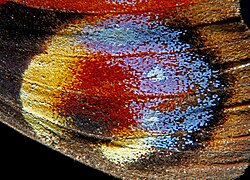| European peacock | |
|---|---|
 | |
| On blackthorn at Otmoor, Oxfordshire, England | |
 | |
| Scientific classification | |
| Kingdom: | Animalia |
| Phylum: | Arthropoda |
| Class: | Insecta |
| Order: | Lepidoptera |
| Family: | Nymphalidae |
| Genus: | Aglais |
| Species: | A. io |
| Binomial name | |
| Aglais io | |
| Subspecies | |
| Synonyms [2] | |
List
| |
Aglais io, the European peacock, [3] [4] [5] or the peacock butterfly, is a colourful butterfly, found in Europe and temperate Asia as far east as Japan. The peacock butterfly is resident in much of its range, often wintering in buildings or trees. It therefore often appears quite early in spring.
Contents
- Characteristics
- Natural history
- Behaviour
- Mating system and territorial behaviour
- Anti-predator defense mechanisms
- Taxonomy
- Gallery
- See also
- References
- External links
The peacock butterfly has figured in research in which the role of eyespots as an anti-predator mechanism has been investigated. [6] The peacock is expanding its range [3] [7] and is not known to be threatened. [7]









